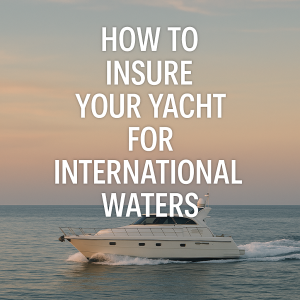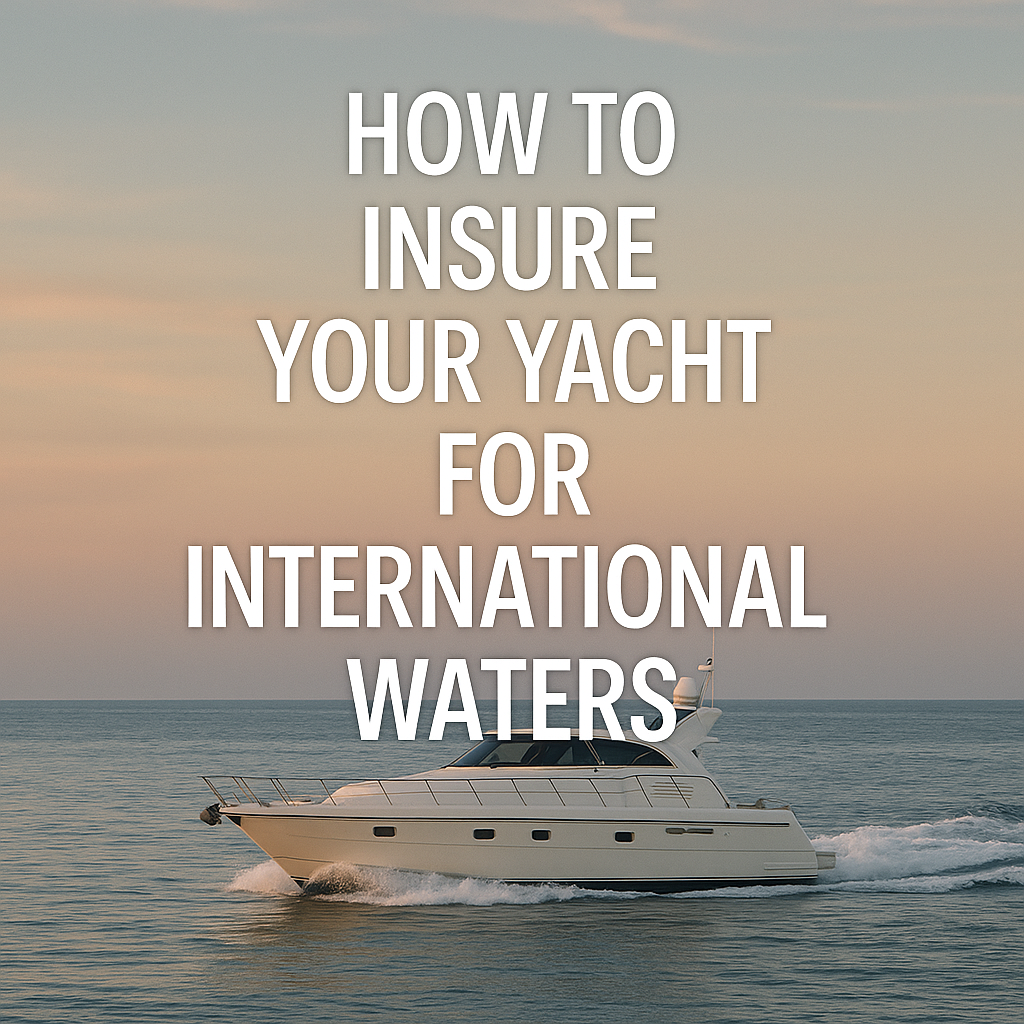Discover how to insure your yacht for international waters with expert insights on marine insurance policies, global coverage, and risk management in this comprehensive 2025 guide. Whether you’re preparing to sail across the Mediterranean, island-hop through the Caribbean, or explore the Arctic Circle, one thing remains constant: you need the right yacht insurance. As the world becomes more connected through leisure boating and long-range maritime travel, ensuring your yacht is properly insured for international waters has never been more crucial.
In this guide, we dive deep into marine insurance policies tailored for international yacht voyages—what they are, why they matter, what they cover (and don’t), and how to choose the best policy for global cruising.
Why Insuring Your Yacht for International Waters Matters
Navigating beyond your national waters isn’t just a matter of adventure—it’s a matter of liability, legality, and logistics.
Legal and Port Entry Requirements
Many countries require proof of marine insurance before granting entry into their waters. This can include third-party liability, salvage coverage, pollution liability, and even crew welfare insurance. Without the correct coverage, you could face fines, detention, or refusal of entry.
Example: In Italy, authorities require non-EU flagged vessels to present liability insurance compliant with Directive 2009/103/EC. Similarly, Australia’s AMSA and Canada’s Transport Canada enforce strict requirements for insurance before port entry.
Financial Protection Against High-Risk Scenarios
International waters introduce added risks:
-
Unpredictable weather
-
Piracy hotspots (e.g., Gulf of Aden, Southeast Asia)
-
Mechanical breakdowns far from support
-
Injuries, evacuations, or salvage operations
According to Lloyd’s List Intelligence, average yacht salvage costs in remote waters can exceed $250,000—a crippling expense without comprehensive marine coverage.

Understanding Marine Insurance for Yachts: The Basics
Marine insurance is not a one-size-fits-all solution. Yacht owners must understand the specific policy types available and tailor them to their navigation plans.
Primary Types of Yacht Insurance
Hull and Machinery (H&M)
This covers physical damage to the vessel due to perils like grounding, fire, or storms. Most international yacht policies will require an H&M clause based on the Institute Yacht Clauses (IYC) standardized by Lloyd’s of London.
Protection and Indemnity (P&I)
Covers third-party liabilities, including injury to others, pollution, wreck removal, and legal defense. This is essential for compliance in many international jurisdictions.
Crew and Passenger Insurance
Required if you employ crew or take paying guests on board. It may include health insurance, personal accident, and even repatriation, as mandated by the MLC 2006 (Maritime Labour Convention).
Personal Effects and Tenders
Covers dinghies, jet skis, and personal gear onboard. Especially important for long-term cruisers.
–
What Makes International Coverage Different?
Yacht insurance for international waters must account for:
-
Navigation limits: Are you covered in pirate-prone zones or politically unstable regions?
-
Extended durations: Some policies are capped at 90 or 180 days away from your home port.
-
Multinational compliance: Are your policies recognized in each country you plan to visit?
Leading underwriters such as Pantaenius, Admiral Marine, and Navigators & General now offer global cruising policies with modular add-ons for piracy, war risks, and environmental liability.
–
Key Developments in Yacht Insurance (2020–2025)
Technological Innovations in Risk Assessment
Modern insurers are using AIS tracking, weather routeing data, and satellite analytics to adjust premiums dynamically. Inmarsat and MarineTraffic now partner with insurers for real-time risk profiling.
“Digital twins and real-time vessel diagnostics have reduced claims related to engine failure by 22% since 2021,” — RINA Journal, 2024
Climate-Driven Risk Recalibration
With hurricanes increasing in strength and shifting geographically, underwriters are updating “named storm exclusions.” For example, the 2023 Cyclone Lola near Vanuatu caused more than $60 million in insured yacht damages.
–
Case Study: Yacht ‘Ocean Nomad’ – From France to Fiji
Skipper Emily Jacobs sailed her 48-ft sailing yacht from La Rochelle, France to Savusavu, Fiji, covering 18 countries in 14 months. Initially insured by a domestic French policy, she had to switch mid-voyage to Jackline Insurance when entering U.S. waters, and again to Bailey Marine in the Pacific.
Lesson: Not all policies are valid worldwide—Emily’s claim for a generator breakdown in Tahiti was rejected because the insurer did not cover French Polynesia.
Her final policy combined:
-
Global navigation coverage
-
War & terrorism clause
-
Evacuation coverage for medical emergencies
-
Crew liability for a rotating team of 2 professionals
Choosing the Right Policy: Factors to Consider
Know Your Navigation Area
Insurers categorize regions:
-
Blue water cruising (transoceanic)
-
Coastal cruising (within 12 nm)
-
Inland waters
Match your itinerary to the correct policy footprint.
Evaluate Insurer Reputation
Use global brokers such as:
-
BIMCO-recommended brokers
-
YachtInsure.com
-
Maritime Mutual
-
North of England P&I Club
Check claim handling reputation on forums like Cruisers Forum or Noonsite.com.
Check What’s Not Covered
Common exclusions:
-
Wear and tear
-
Defective parts (unless machinery clause applies)
-
War zones (unless explicitly included)
-
Charter activity (without declaration)
–
FAQ: Yacht Insurance for International Waters
1. Do I need yacht insurance to sail internationally?
Yes. Most countries require at least third-party liability. Without it, you may be denied port entry.
2. Will my domestic yacht insurance cover me abroad?
Usually not. Domestic policies often have strict navigation limits and do not comply with international port authorities.
3. How much does international yacht insurance cost?
Expect to pay 0.8–1.5% of your yacht’s value annually for full international coverage, depending on risk factors.
4. Can I get insurance if I sail solo?
Yes, though it may limit certain claims. Some underwriters charge higher premiums or exclude offshore solo passages.
5. Is piracy covered under yacht insurance?
Only if explicitly included. Check for a “war risks” or “piracy” clause.
6. What happens if I switch insurers mid-voyage?
Possible, but tricky. Notify the new insurer of existing conditions or claims history to avoid policy nullification.
7. Does insurance cover emergency evacuation or repatriation?
Many comprehensive policies now include this, especially for global cruisers or yachts with paying guests or crew.
Conclusion: Navigating Smart with the Right Coverage
Insuring your yacht for international waters isn’t just smart—it’s essential. As yachts venture farther afield into complex jurisdictions, varied climates, and new geopolitical challenges, a tailored marine insurance policy is the skipper’s best defense.
Whether you’re a seasoned bluewater sailor or planning your first Atlantic crossing, take the time to:
-
Understand what coverage you need
-
Select a reputable provider
-
Stay informed on regional risks
-
Update your policy annually or when your itinerary changes
Your yacht is your freedom—make sure it’s also protected.
References
-
International Maritime Organization (IMO): www.imo.org
-
Lloyd’s List Intelligence: www.lloydslistintelligence.com
-
RINA Journal: www.rina.org.uk
-
Inmarsat Maritime Safety Services: www.inmarsat.com
-
MarineTraffic Vessel Tracking: www.marinetraffic.com
-
BIMCO Guidance on Insurance: www.bimco.org
-
Transport Canada: www.tc.canada.ca
-
AMSA (Australia): www.amsa.gov.au
-
Noonsite Global Cruising Info: www.noonsite.com
-
Pantaenius Yacht Insurance: www.pantaenius.com



Can you insure P@I coverage for 50ft trawler while it’s on the hard standing in Australia.
Regards
Alexander Hay
Hi Alexander,
Yes — it is generally possible to insure P&I-type liability coverage for a private 50-ft trawler while it’s laid up “on the hard” in Australia, but with some important caveats:
P&I clubs (mutuals): The International Group P&I Clubs normally cover commercial vessels, not private yachts. A 50-ft trawler (if used as a pleasure craft) wouldn’t usually qualify for full “blue-water” P&I.
Yacht insurers: Yacht policies often bundle hull & machinery with third-party liability (sometimes referred to as “P&I” in the yacht context). When the vessel is ashore (on hard standing, cradle, or dry dock), you can request “laid-up” cover, which reduces premium but still maintains liability protection in case of fire, pollution, or damage to third parties while on land.
Australia specifics: Major providers active in Australia include Club Marine, Nautilus Marine, Pantaenius, and Topsail, all of which offer third-party liability options for pleasure craft, including while stored ashore. Some global yacht underwriters (Lloyd’s syndicates, Allianz, etc.) also extend this type of cover.
Scope: Coverage usually includes
liability for damage your boat might cause to other vessels or property while ashore,
pollution liability,
sometimes limited crew/passenger liability (depending on whether you declare crew).
What to do next:
Ask insurers for a “laid-up ashore” endorsement on your policy.
Confirm whether liability remains active during hard standing (some reduce or exclude it unless explicitly added).
If your trawler is coded/used commercially, you may need a specialist marine insurer rather than a yacht leisure policy.